Can Arctic Cat Survive?

Arctic Cat enters a crucial point in its life as it searches for a new CEO
Can Arctic Cat survive into the future as a viable and independent snowmobile manufacturer? It’s a question that some business analysts have begun to ask – very subtly, but very real nonetheless.
The undertones of the question would have started during this past year as industry watchers couldn’t help but see Arctic Cat stock (traded as ACAT on the NASDAQ) drop from a 52-week high of US$61.13 down to US$31.95. That’s nearly half the value!
If like me you didn’t own any Arctic Cat stock you probably didn’t care. Truthfully we only took note on June 2 of this year, that was when Arctic Cat announced the sudden departure of CEO Claude Jordan. That’s when we checked the stock prices, saw the drop and understood the return of former Cat executive Chris Twomey, who headed up the company from 1986 to his retirement in 2012. After a yearlong retirement he has come back to ACAT as its interim CEO.
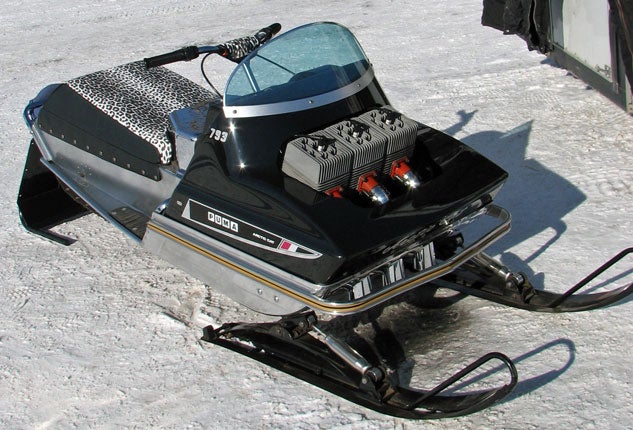 The current Arctic Cat traces its lineage to the iconic 793cc Puma and before!
The current Arctic Cat traces its lineage to the iconic 793cc Puma and before!His job will be to hold things together while a new chief executive can be found, vetted and put into position. In the meantime, we note that Twomey managed to quell most unrest as he announced ACAT’s first quarter financial results, stating: “… In my current position as Interim CEO and Chairman of the Board, I’m once again pleased to be able to work with the talented team that I believe has tremendous opportunities to move the company forward. Even though my current agreement with the Board has me here through September, the team has already begun a number of key projects that will take the company strongly forward even after I again retire.
“Net sales were up 19% to US$143.6 million which are record first quarter sales for Arctic Cat. Sales were driven by very strong snowmobile sales, which were up 149%. About half the increase came from sales to our OEM partner (Yamaha), which last year were primarily made in our third quarter and this year will be mostly spread between the first quarter and second quarter.
One Year Later: The Arctic Cat/Yamaha Deal
“Retail sales reporting doesn’t begin until September, so can’t give you any real color on snowmobile retail activity at this time, other than to say that our extra early sales… made to customers prior to the end of last fiscal year. This year we’re nearly 10% ahead of last year. To a great extent, this is driven of course by the 14 new models we introduced in the 2015 model year.
“… Wholesale sales of ATVs were down in the quarter as we tried to lower dealer partner inventories prior to the September ATV show, where we will be introducing 14 new models.
“… Overall net income was down for the quarter, primarily due to product mix in snow, as well as the Canadian exchange rate… We still anticipate the year to result in record-breaking sales and at the same time we continue to make investments in R&D to drive our future.”
As Twomey explained the reality of Arctic Cat for the fiscal year, not all analysts bought head long into the strengths. One analyst expressed skepticism noting that ACAT’s guidance implied growth “…far in excess of what the company has done historically and even recently,” adding that he saw risks associated with the recent unexplained management transition.
Looking at snowmobiling and the snowmobile industry from the outside, the analyst cautioned that since the snowmobile is a 60-year-old product that has not changed in basic design since its beginnings, he would not be surprised if the industry is experiencing a long-term decline.
| Estimated Snowmobile Sales | |||||
| Region | 2013-2014 Sleds Sold (estimated) | 2012-2013 Sleds Sold (estimated) | 2011-2012 Sleds Sold (estimated) | 2010-2011 Sleds Sold (estimated) | 2009-2010 Sleds Sold (estimated) |
| United States | 54,028 (35%) | 48,536 (34%) | 48,689 (38%) | 51,796 (42%) | 49,200 (44%) |
| Canada | 48,758 (31%) | 44,022 (30%) | 40,165 (31%) | 40,878 (33%) | 37,600 (34%) |
| Europe & Russia & other | 54,320 (35%) | 52,043 (36%) | 40,233 (31%) | 30,389 (25%) | 24,300 (22%) |
| Total | 157,106 | 144,601 | 129,087 | 123,063 | 111,100 |
Of course, Arctic Cat is more of a “wheeler” than a “track and ski” company these days, but our analyst expressed concerns that ATVs, too, are in long-term decline due to the popularity of Side-by-Sides. Despite his pessimism he acknowledged that as sales of Side-by-Sides increase at a higher rate than the ATV decline, the combination of the two is actually resulting in overall growth.
This analyst is not alone in his concerns about ACAT, not so much for the viability of the company itself, but for recommending profitability of the stock.
Jim Cramer of CNBC took close notice of Arctic Cat’s fiscal performance, commenting: “Good management makes an enormous difference in the performance of a stock.”
He pointed out that since both Polaris and Arctic Cat produced similar products, investors treated them the same, until after their financial reports were released. Then investor attitude shifted significantly.
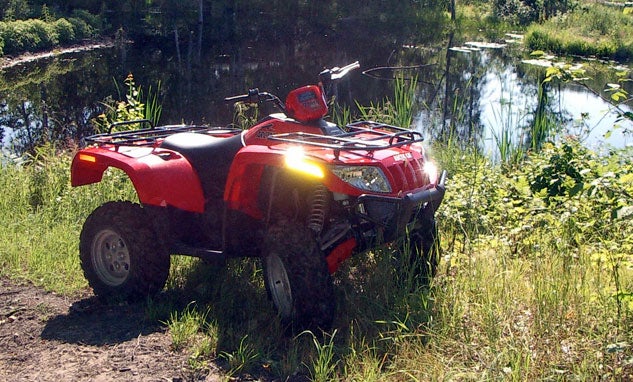 Arctic Cat’s ATV and UTV business is bigger than its sled biz.
Arctic Cat’s ATV and UTV business is bigger than its sled biz.Explained Cramer, “Arctic Cat produced an awful quarter while rival Polaris delivered a 3-cent earnings beat with higher than expected revenues.”
Cramer noted that the Street quickly realized that sales were very different at the two companies.
“Polaris experienced a 25% increase in off-road vehicles. At Arctic Cat they were up just 4.3%,” he said.
Snowmobile Sales Climb 9.2% for 2013-2014
He concluded that Arctic Cat’s management just wasn’t able to execute as effectively as the management team at Polaris and resulted in shares of Arctic Cat dropping more than 10% in five days.
Another Canadian-based snowmobile business industry watcher actually espouses a merger between Arctic Cat and its current snowmobile product partner Yamaha. This certainly seems far-fetched. He estimates Arctic Cat holds a 21 percent market share in a snowmobile business that accounted for 157,106 unit sales this past season. Compare that to Yamaha, which according to its 2014 Fact Book sold 26,000 sleds, representing a 17 percent worldwide market share. But, of that total fewer than 10,000 units were sold in North America as Yamaha’s percentage of market in Russia and Scandinavia is nearly double that.
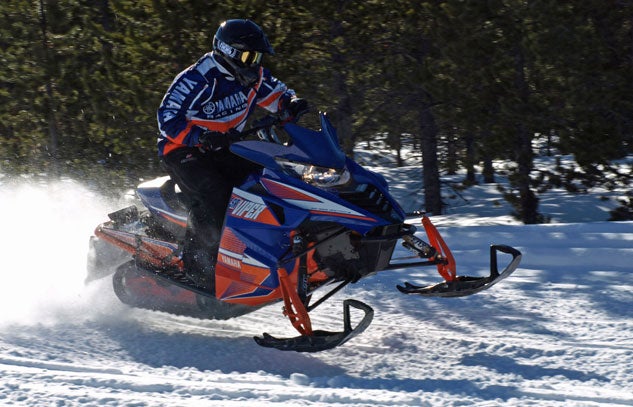 Despite denials from both sides, the rumors of a Yamaha takeover of Arctic Cat started when the engine-for-chassis partnership was announced.
Despite denials from both sides, the rumors of a Yamaha takeover of Arctic Cat started when the engine-for-chassis partnership was announced.Cat may have an advantage in sled sales, but when you look at Yamaha’s total financial wherewithal, the Japanese-based company’s US$13.7 billion in total corporate revenues swamps ACAT’s US$730 million. This seems to be the reasoning why one analyst suggests “… a decent probability of Yamaha Motor Co. buying ACAT.”
He bases that on the February 2013 arrangement with Yamaha where Cat would build performance-based snowmobiles for Yamaha on a Cat chassis and Yamaha would provide Arctic Cat with four-stroke engines.
He also notes “…since the deal was announced, both companies have praised one another.” We agree with the praise assessment, but don’t see that resulting in a merger anytime soon.
However, he does note that one of Cat’s challenges is growing its dealer network by adding new dealers and convincing existing ones to allocate more space to Arctic Cat products.
Based on his company’s research, “Yamaha has about three times more dealers than Arctic Cat in North America.” He suggests that Yamaha does not enjoy the stronger presence in smaller counties that Arctic Cat’s brand does. On the flip side, in the “metro” regions of larger population centers, Yamaha’s strength might benefit Arctic Cat.
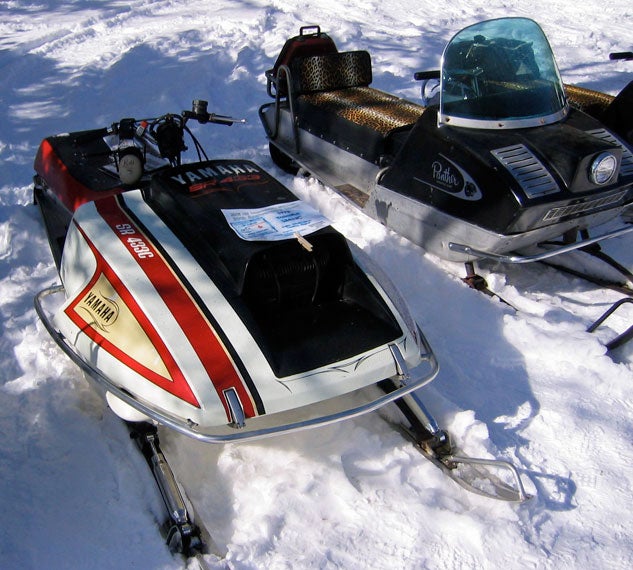 You’ll find Cats and Yammies sharing history at many swap and vintage events across the snowbelt.
You’ll find Cats and Yammies sharing history at many swap and vintage events across the snowbelt.“From an operational point of view, Yamaha could teach ACAT a thing or two about product quality and ACAT could show Yamaha that in order to improve speed to market, you don’t need to bring in 17 engineers and do two years of testing every time you wish to change a nut on a product,” the analyst suggests.
According to this watchful insider, “An acquisition of ACAT would move the needle for Yamaha, increasing its sales by more than five percent…. Power Products, which includes all-terrain vehicles and snowmobiles, is Yamaha’s third-largest division, generating nine percent of its total sales. An acquisition of ACAT would increase the size of this division by more than 60 percent.”
He does note that “the biggest caveat to our acquisition thesis” is that historically in the North American market, Yamaha Motors is not an acquisitive type of company.
Beyond 2015: What Does the Snowmobile Future Hold?
The whole idea of Yamaha and Arctic Cat joining together in a merger, planned buy-out, take-over or whatever you might call it is not new. The talk surfaced when Yamaha and Cat joined together with the first Cat-built, Yamaha-powered kid sled – the blue SRX 120 for Yamaha and the ZR 120 for Arctic Cat. When the engines-for-chassis agreement was announced, well, let’s just say that Yamaha Vice-President of Sales and Marketing Peter Smallman-Tew was busy quashing rumors of an impending Yamaha/Arctic Cat merger. He has told Snowmobile.com on more than one occasion that there is no planned merger now or down the trail.
Still, those rumors persist. The survival of Arctic Cat would seem to be secure as an iconic brand and as an independent company into the future. That is not to say that the new chief executive brought into Cat to drive its future won’t be faced with decisions and choices that will affect the company and its 1,611 employees. He will have opportunities galore as Arctic Cat may want to be more aggressive.
As that executive search gets underway, we would offer our own thoughts. In our opinion, Arctic Cat as a company needs to decide what it wants to be. It cannot worry about what products other companies are creating. It needs to have a better understanding of its own capabilities and how to fit into the future of powered recreation. The new chief executive certainly needs to come on board with his own vision of what Arctic Cat is and will be into the future. The board of directors must be prepared to back him, even if it means totally rethinking the company, its leadership and its product advances. The new person may face some very hard decisions. But for Arctic Cat to move forward there will need to be innovations.
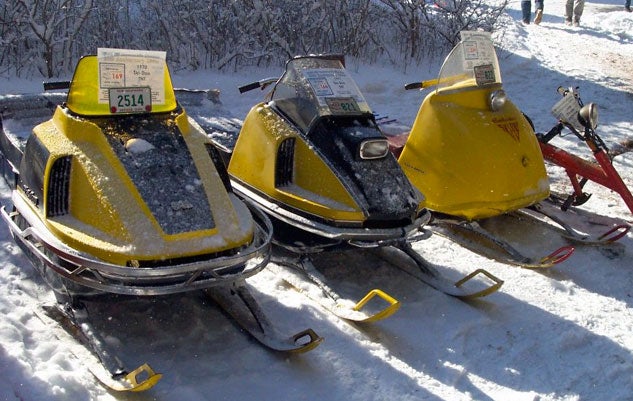 Ski-Doo’s place in snowmobiling history pre-dates Arctic Cat.
Ski-Doo’s place in snowmobiling history pre-dates Arctic Cat.Many of the key people now at Arctic Cat have been there since the old “Arctco” days when the Cat fought back from Arctic Cat Inc.’s bankruptcy. Are they like Chris Twomey, 65-years-old, ready for a well-earned retirement? Or, are they forward thinking, creative and innovative?
Right now, we look at Arctic Cat and see a company that is dwarfed by its peers. Its engine-partner Yamaha brings in close to US$14 billion in annual revenues with more than 53,000 employees worldwide. Its northern Minnesota competitor, Polaris, has 5,400 employees and has sales of US$3.8 billion. Ski-Doo’s parent company, BRP Inc., employees 7,100 people worldwide and drove annual revenues to US$3 billion. Those companies compete head-to-head in snowmobiles and wheeled ATV and UTV products with Arctic Cat, which reported total revenues of US$730 million and a work force of 1,611 people.
| The Snowmobile Makers | |||
| Manufacturer | Total Employees | Total Revenues (US$) | Year Company Founded |
| Yamaha | 53,380 | $13.7 Billion | 1955 (First Snowmobile, 1968) |
| Polaris | 5,400 | $3.8 Billion | 1954 |
| BRP Inc (Ski-Doo) | 7,100 | $3.0 Billion | 2004 (First Snowmobile, 1959) |
| Arctic Cat | 1,610 | $730 Million | 1961 (Arctco, 1982) |
So, when Arctic Cat stock plummets from a high of US$60 down to just over US$30 and its CEO gets canned, can you blame business analysts for asking what’s going on and wondering if Arctic Cat can survive?
The hiring of the next Arctic Cat chief executive will be significant to the company’s bottom line, its perception in the market place and crucial to the company’s future. But, hey, there’s no pressure!
As for us, we fully expect that Arctic Cat will survive as both an iconic brand and as a company.








 Your Privacy Choices
Your Privacy Choices